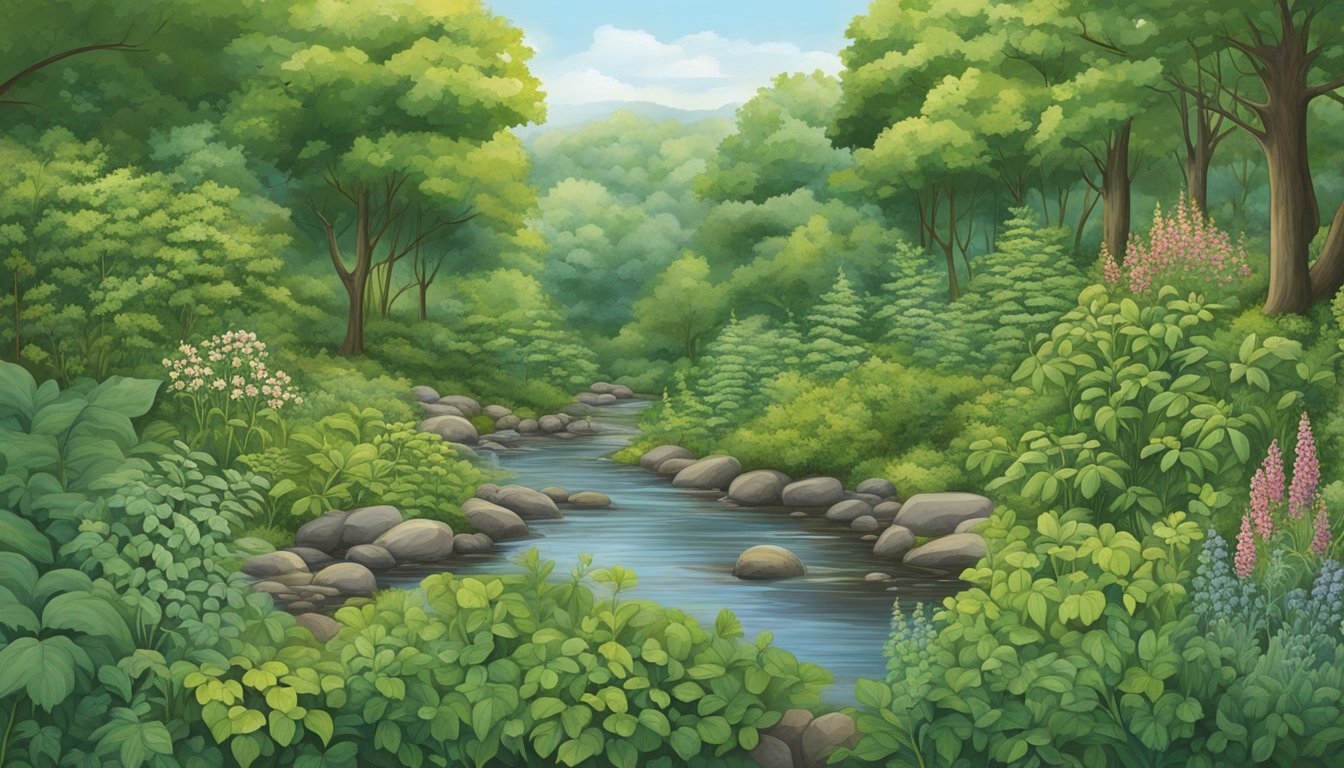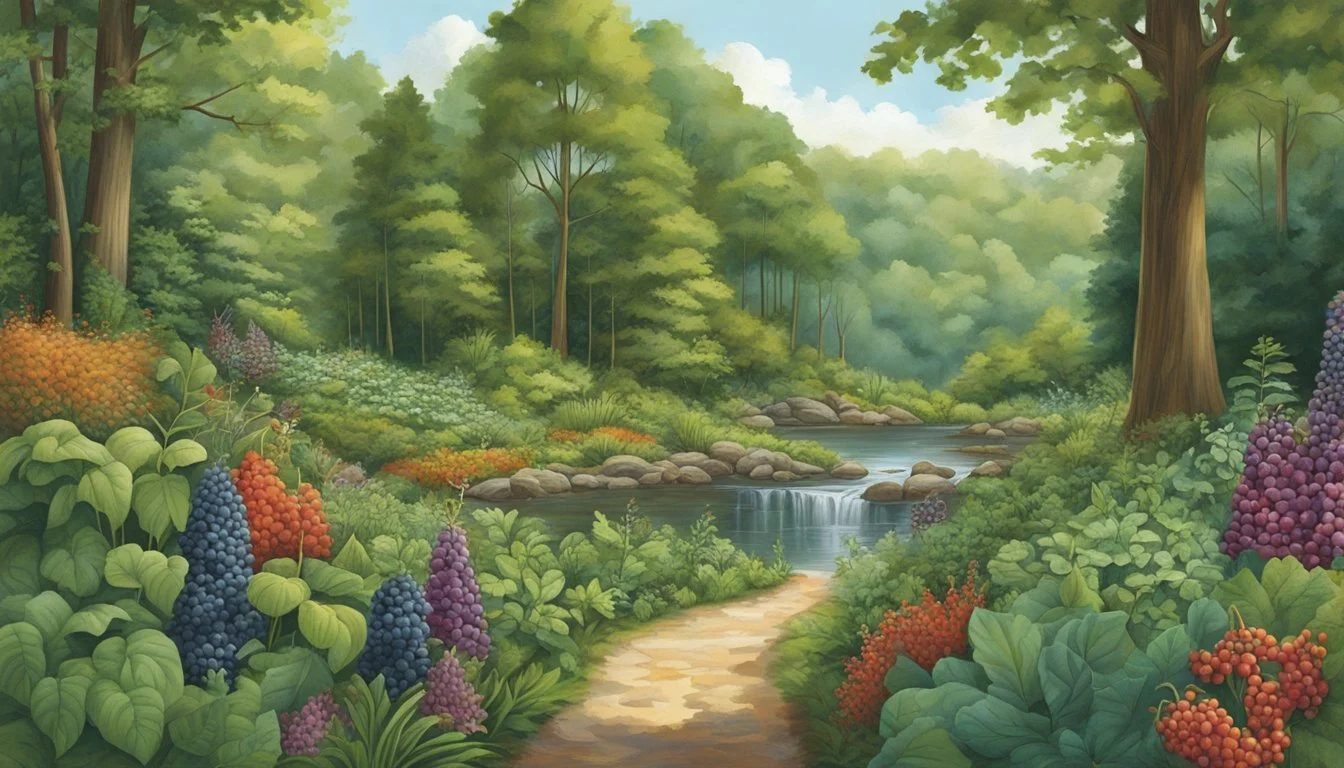Native Edible Plants in New York
A Guide to Foraging Local Flora
This Article is Part of Foraging Guide for All 50 US States
New York's landscape offers a bounty of native edible plants, which have been foraged and utilized by inhabitants for centuries. From the lush forests of the Adirondacks to the rolling fields of the Hudson Valley, these plants not only contribute to the region's biodiversity but also provide a natural, nutritious food source. Many of these species, like the wild ramp, are celebrated for their unique flavors and have seen a resurgence in popularity due to the local food movement.
In urban areas such as New York City, foraging for edible plants in public parks has become a way for residents to connect with nature and understand local ecosystems. In rural and wilder regions, native species like the pawpaw, the northernmost member of the tropical custard apple family, grow abundantly and are prized for their creamy, custard-like fruit. Additionally, plants such as the Jerusalem artichoke, a species of sunflower, are notable for their versatility and the ease with which they can be incorporated into various culinary dishes.
The interest in these native edible plants extends beyond foraging. It encompasses conservation efforts and educational programs aimed at promoting a sustainable relationship with the natural environment. As people seek to diversify their diets with more local and wild foods, understanding the variety and uses of New York's native plant species is becoming increasingly important. This interest serves as a bridge between past and present, offering a taste of the region's rich ecological heritage while encouraging a deeper respect for the land.
Interested in Mushroom Hunting in New York?
New York's diverse forests and abundant rainfall make it a prime location for mushroom hunting. From the Adirondacks to the Catskills, the state offers a variety of edible species, including morels, chanterelles, and hen of the woods. With proper identification skills and respect for regulations, foraging in New York promises a rewarding adventure.
👉 Guide on Mushroom Hunting in New York
Understanding Native Edible Plants
Exploring the realm of native edible plants in New York uncovers a connection between historical traditions and modern practices. It highlights the rich biodiversity of native flora and its integral role in ecological health, promoting a responsible approach to foraging and cultivation.
Historical Significance
New York's native plants have been fundamental to the diet of Native Americans for centuries. Species like the wild strawberry and wild leek, or ramps, were commonly gathered and used in a variety of dishes. Their understanding of the land's resources fostered a deep connection with native plant communities.
Classification of Native Flora
In New York, native edible plants encompass a broad range of species, including trees, flowers, and leaves. Key species involve diverse flowers like the serviceberry and various edible leaves from native trees, contributing to the region's biodiversity.
Ecological Importance
Native plants are vital for maintaining ecological health and supporting native habitats. They form the foundation of local plant communities, offering sustenance for wildlife and promoting a balance with invasive plant species.
Benefits and Uses
Native edibles provide not only food in the form of jams, salads, and herbal teas, but also medicinal uses. The native plants are used for both their nutritional value and their healing properties.
Foraging Basics and Ethics
Foraging in the wilderness requires a responsible approach. Collecting plants should be done with caution, avoiding areas treated with pesticides or herbicides, and adhering to sustainable practices to protect native species and habitats.
Legal Considerations
There are legal frameworks in place affecting foraging on both public and private lands. Knowledge of these regulations is essential to ensure compliance when harvesting native plants.
Safety and Identification
Accurate identification is critical for foragers to ensure safety. Using resources such as guides from reputable organizations can prevent the accidental ingestion of toxic plants.
Cultivation in Gardens
Cultivating native plants in a garden not only preserves these species but also benefits local pollinators like butterflies and bees. It encourages the growth of native plants outside their native habitats.
Seasonal Guide
A seasonal guide informs on the optimal times for harvesting different species, ensuring peak freshness and nutritional value while respecting the growth cycle of native plants.
Conservation Efforts
Conservation efforts by various organizations focus on protecting native edible plants, ensuring their availability for future generations, and maintaining healthy ecosystems.
Community Initiatives
Local communities engage in initiatives that encourage the cultivation and use of native edibles, fostering a collective effort in preserving and utilizing local plant species.
Educational Resources
Educational resources provided by environmental groups and extension services offer valuable information on native edible plants, assisting in spreading knowledge and fostering community involvement.
Edible Plant Profiles
This section provides an informative showcase of various edible plants native to New York, detailing their characteristics and potential uses.
Berries
Highbush Blueberries (Vaccinium corymbosum): Thriving in woodland clearings, highbush blueberries are sweet fruits that can be consumed fresh or used in jams and baking.
American Elderberry (Sambucus canadensis): Found in moist areas, elderberries have immune-boosting properties when cooked and are popular in syrups and pies.
Roots and Tubers
Wild Leek (Allium tricoccum): Also known as ramps, wild leeks have a garlic-onion flavor and can be used in a variety of dishes.
Wild Carrot (Daucus carota): The root of the wild carrot, or Queen Anne's lace, is edible when young but becomes woody with age.
Leafy Greens and Herbs
Dandelion (Taraxacum officinale): All parts of the dandelion are edible, with leaves adding a bitter note to salads and the flowers used in making wine. Mugwort (Artemisia vulgaris): Offering a bitter, aromatic flavor, mugwort leaves can be used in teas and as a culinary herb.
Nuts and Seeds
Walnut (Juglans spp.): Nuts (how long do nuts last?) from walnut trees provide rich flavor and nutritional value, often used in baked goods.
Hazelnut (Corylus Americana): Hazelnuts, or filberts, can be eaten raw or roasted, featuring in various confections and snacks.
Wild Mushrooms
Mushrooms should be harvested with caution as misidentification can lead to poisoning.
Morels (Morchella spp.): Hollow, honeycomb-patterned mushrooms favored for their nutty taste.
Chanterelles (Cantharellus cibarius): Known for their golden hue and fruity, peppery flavor, ideal in gourmet dishes.
Aquatic and Wetland Plants
Cattails (Typha spp.): Providing starch-rich rhizomes, the inner shoots and pollen of cattails are also edible.
Watercress (Nasturtium officinale): A spicy, leafy green found in running water and used in salads or as a garnish.
Trees with Edible Components
Black Locust (Robinia pseudoacacia): Their fragrant blossoms can be battered and fried or used to flavor desserts.
Serviceberry (Amelanchier spp.): Also known as juneberries, their sweet fruits are excellent in jams and desserts.
Invasive Edible Plants
Garlic Mustard (Alliaria petiolata): An invasive yet edible plant with a garlic-flavor, it can be used in pesto and salads.
Japanese Knotweed (Fallopia japonica): With a tart, rhubarb-like taste, its young shoots can be consumed in pies and jams.
Medicinal Plants and Their Uses
Purple Coneflower (Echinacea purpurea): Recognized for immune-boosting effects, the roots and flowers are used in herbal remedies. Monarda Didyma: Known for its antibacterial and antifungal properties, it is often used in teas and herbal infusions.
Rare or Lesser-Known Species
Solomon’s Seal (Polygonatum biflorum): Its roots are traditionally prepared as a starch-like vegetable.
Pawpaw (Asimina triloba): This lesser-known fruit has a tropical taste similar to banana and mango, suitable for fresh eating and desserts.
Fruits and Sweet Treats
Strawberries (Fragaria spp.): Wild strawberries are smaller than cultivated varieties but are intensely flavored, ideal for fresh eating and jams. Pawpaw: Noted for its custard-like flavor, pawpaw fruit can be used in baking or enjoyed as is.
Plants for Flavoring and Spices
Wild Leeks (Allium tricoccum): Ramps add a distinctive onion-garlic taste to dishes.
Dandelions: Their flowers, leaves, and roots can be used to make a bitter, yet flavorful addition to teas and dishes.
Culinary Practices and Recipes
Incorporating native edible plants into daily meals invigorates the culinary landscape of New York with homegrown flavors. This section unfolds techniques and traditions spanning from the simple preparation of wild greens to the intricate crafting of preservable delicacies.
Preparing Wild Edibles
Gathering edible plants such as dandelions and ramps requires knowledge of their habitats and seasons. Cleaning them thoroughly is essential since they grow in the wild. Leaves, flowers, and shoots from plants like dandelion and wild leeks can be rinsed and used raw in salads or cooked.
Cooking Techniques
Simple cooking methods like steaming or sautéing can enhance the natural flavors of wild berries, nuts, and greens. For instance, sautéed ramps with a dash of salt can serve as a robust accompaniment to meats. Transforming foraged dandelion greens into savory delicacies involves brief blanching to reduce bitterness.
Preservation Methods
Drying: Suitable for herbs and flowers to extend their usage.
Pickling: Ramps and other wild edibles can be pickled.
Jamming: Wild berries are often turned into jams for long-term storage.
Preserving amplifies the shelf life of edibles, ensuring a year-round supply.
Herbal Teas and Infusions
Herbal teas made from locally foraged plants not only impart unique flavors but also offer medicinal properties. Steeping dried dandelion flowers produces a tea believed to have detoxifying benefits.
Seasonal Recipes
Spring: Raw salad featuring dandelion greens and ramps dressed with vinaigrette. Summer: Jams from berry species like blackberries and mulberries. Fall: Acorn flour (how long does acorn flour last?) pancakes from ground nuts. Winter: Preservation methods keep seasonal flavors available.
Recipes adapt to the edible species available in each season.
Foraged Food Pairings
Dandelion Salads: Pair with meats or eggs for a satisfying meal.
Jams: Complement breads or pastries.
Flour: From acorns, creates earthy breads or pastries.
Selecting compatible foods enhances the culinary experience of foraged edibles.
Environmental Impact and Sustainability
The inclusion of native edible plants in diets has several environmental implications. Understanding the dual facets of sustainability and ecosystem health requires examining both the potential strain from overharvesting and the opportunities for habitat restoration.
Impact of Foraging on Ecosystems
Foraging for wild plants in New York can lead to significant ecological disturbances if done irresponsibly. Overharvesting can deplete plant populations, disrupt wildlife food sources, and adversely affect soil health and composition. Native habitats can suffer from the loss of species that play key roles in ecological networks.
Consequences of Foraging:
Diminished plant populations.
Disrupted animal diets.
Altered soil composition.
Sustainable Foraging Guidelines
Adhering to sustainable foraging practices ensures minimal negative impacts on nature. Collectors are encouraged to:
Harvest responsibly: Taking only a small, sustainable amount and leaving enough for regeneration.
Identify correctly: Ensuring accurate identification to protect native species and avoid the removal of rare or endangered plants.
Stay informed: Keeping abreast of local regulations related to foraging and protected areas.
Restoration of Native Plant Life
Efforts to restore native plant life contribute positively to ecological health. Initiatives that replant native species, remove pests, and manage ecosystems not only support biodiversity but also strengthen resilience against environmental changes.
Restoration Activities:
Replanting native flora.
Managing pest populations.
Educating the public on native species preservation.
Reducing the Spread of Invasive Species
Invasive plant species outcompete native plants, disrupt ecological balance, and can become significant pests. Measures to control their spread include:
Preventative actions such as planting buffers of native species.
Early detection and rapid response (EDRR) programs to identify and manage invasives quickly.
Public education on identifying and reporting invasive species to appropriate authorities.
Wildlife Interactions and Coexistence
Interactions between wildlife and native edible plants in New York play a crucial role in maintaining ecological health. These dynamics underscore the importance of each species in supporting the others, reflecting a balanced ecosystem.
Pollinators and Edible Plants
Pollinators such as bees and butterflies are indispensable for the reproduction of many native plants. Their activity ensures the persistence of species like the Rubus odorus (purple-flowering raspberry), which provides nectar for pollinators and edible fruit for humans.
Species of Pollinators:
Bees: Critical for cross-pollination.
Butterflies: Aid in pollen transfer among flowers.
Role in Ecology:
Ensuring plant reproduction.
Supporting food webs by pollinating edible plants.
Birds and Berry-Producing Plants
Birds rely on berry-producing plants for sustenance while contributing to seed dispersal and plant propagation. For instance, the red mulberry tree (Morus rubra) produces berries that feed a wide variety of birds, including the American robin (Turdus migratorius), which in turn helps scatter the seeds to foster new growth.
Interrelationships:
Bird Species: Migratory and resident birds disperse seeds.
Plants: Berry producers like Vaccinium angustifolium (lowbush blueberry) support bird populations.
Insects and Native Flowers
Insects interact with native flowers, affecting both the viability of the plants and the insects' own survival. Native species like the eastern tiger swallowtail butterfly (Papilio glaucus) find nourishment from flower nectar, while simultaneously assisting in the plants' reproductive processes.
Key Dynamics:
Insect Contribution: Pollination and plant growth support.
Flower Attraction: Providing essential habitats and food sources for insects.
Gardening and Propagation
Understanding the specific needs of native edible plants in New York is key to successfully cultivating these species in a garden setting and ensuring a bountiful harvest.
Growing Edible Native Plants
When starting a garden of edible native plants, it is crucial to choose species that are well-suited to the local climate and soil conditions of New York. For example, the Jerusalem artichoke (Helianthus tuberosus) thrives in full sun and well-draining soil. Planting should be executed with care to spacing, typically 18-24 inches apart, to allow for adequate growth. Native fruit-bearing shrubs like the Serviceberry (Amelanchier spp.) require a mixture of sun and partial shade, and benefit from mulching to retain soil moisture.
Pruning Practices
Effective pruning maintains the health and productivity of native edible plants. Each species has specific requirements; for instance, Black raspberry (Rubus occidentalis) canes should be pruned in the early spring to remove dead canes and encourage new growth, ultimately leading to a better yield of berries. For elderberry (Sambucus canadensis), pruning is best done by removing older stems to promote the development of younger, more vigorous growth that will produce more fruit.
Encouraging Pollinators
A garden reliant on native edible plants should support local pollinators, which are essential for plant reproduction and fruit development. Flowering plants can draw in pollinators such as bees and butterflies; a diverse range of plant species will ensure a consistent presence of these beneficial insects. To attract a variety of pollinators, one can plant wildflowers like Milkweed (Asclepias spp.) and Goldenrod (Solidago spp.) alongside edible plants to provide a habitat and food sources throughout the growing season.
Conservation and Management Strategies
In New York, the conservation of native edible plants involves strategic planning and active management. These efforts ensure the survival of unique species and maintenance of biodiversity.
Protecting Native Plant Species
Protection of native plant species is critical for maintaining biodiversity. Strict laws and regulations have been imposed to safeguard these plants from overharvesting and habitat destruction. Initiatives such as the New York State Department of Environmental Conservation's Native Plant Program focus on preserving native habitats, which are essential for native plants' survival.
Legal Protections:
Prohibitions against unauthorized wild plant collection
Penalizing habitat destruction
Conservation Programs:
Seed bank collections
Restoration projects for endangered species
Management of Public and Private Land
Management practices on both public and private lands are instrumental in preserving the native ecosystems of New York. On public lands, rangers and ecologists manage areas to promote the growth of native species, often through controlled burns or the removal of invasive species. Private landowners are encouraged to implement sustainable landscaping with native plants, contributing to larger conservation efforts.
Public Land Strategies:
Periodic ecological assessments
Habitat restoration initiatives
Private Land Incentives:
Educational programs for landowners
Grants for private conservation projects
Engaging with Conservation Organizations
Partnerships with conservation organizations amplify the impact of individual and state efforts in protecting native edible plants. Organizations such as the Native Plant Trust and The Nature Conservancy work with various stakeholders to secure the needed resources and expertise for conservation activities. They hold workshops and volunteer events to educate the public on the value of native species and habitats.
Collaborative Events:
Public workshops on native plant cultivation
Volunteer habitat restoration days
Resource Sharing:
Distribution of guidelines for plant conservation
Shared databases for tracking plant populations
Appendix
The Appendix serves as a comprehensive guide for readers to understand specialized terms, consult reference materials, and explore more resources related to Native Edible Plants in New York.
Glossary of Terms
Botanical Nomenclature: The formal, scientific naming of plants.
Cultivar: A plant variety that has been produced in cultivation by selective breeding.
Foraging: The act of searching for and collecting food resources in the wild.
Native Species: Plants that occur naturally in a particular region, ecosystem, or habitat without human introduction.
Perennial: A plant that lives for more than two years.
Seasonality: The time of year when a particular type of plant is in season, or ripe for harvesting.
Reference Materials
The following table lists key reference materials that establishe a foundation for further study of Native Edible Plants in New York:
Resource Type Title Author(s) Year Notes Field Guide Edible Wild Plants: Eastern/Central North America Lee Allen Peterson 1999 Comprehensive guide with illustrations. Academic Journal Economic Botany Society for Economic Botany Varies Includes peer-reviewed articles on ethnobotany and economic botany. Government Publication Plant Profiles USDA Natural Resources Conservation Service Varies Profiles on native plants including edible species.
Further Reading and Resources
For those seeking additional information, the following resources provide in-depth knowledge and are reputable sources for Native Edible Plants in New York:
Books:
"Northeast Foraging: 120 Wild and Flavorful Edibles from Beach Plums to Wineberries" by Leda Meredith.
"The Forager's Harvest: A Guide to Identifying, Harvesting, and Preparing Edible Wild Plants" by Samuel Thayer.
Websites:
New York Flora Atlas (newyork.plantatlas.usf.edu) for locating and identifying plant species across New York State.
Cornell University Plant Database (plants.cornell.edu) offers extensive plant descriptions, including edible plants.
Organizations:
New York Botanical Garden provides workshops on plant identification and use.
Wild Food Adventures offers foraging tours and educational programs.




